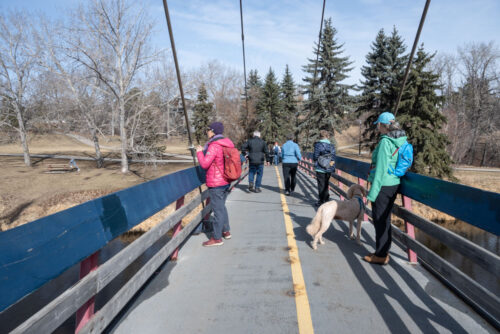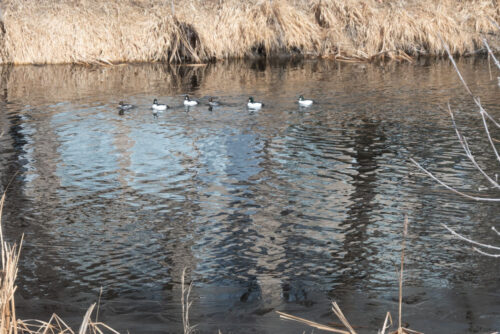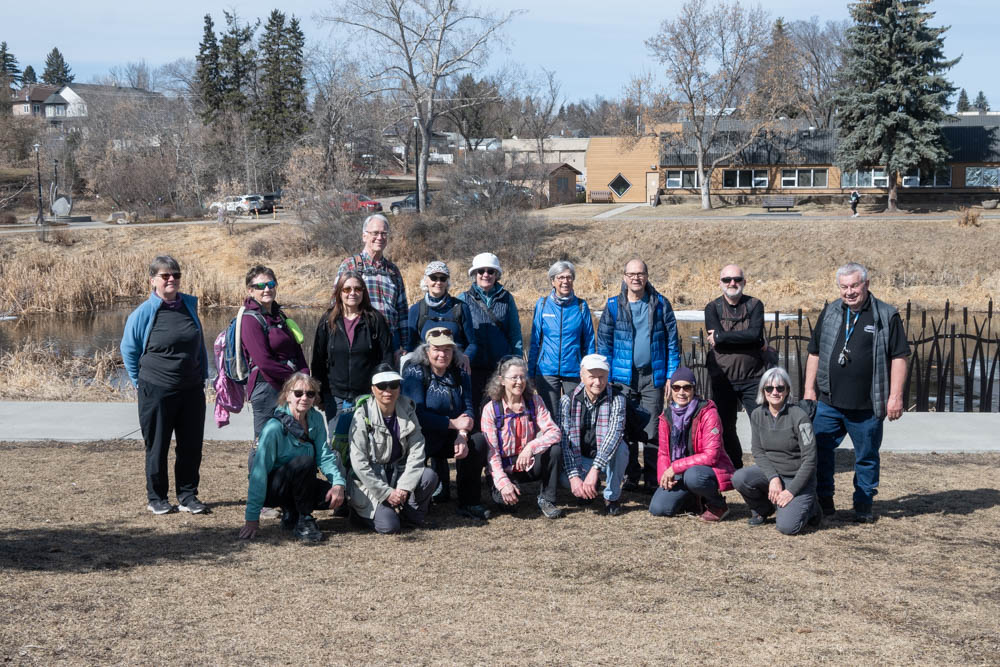By Pat Trautman, presented at the Annual General Meeting on April 11, 2024
Introduction
The Waskahegan Trail
I grew up as a young farm boy three miles west of New Norway, about 5 miles away from the Battle River Valley. The Battle River Valley was a magical place in our youth, a place that we got to visit quite often.
My father acquired River Lots 30 and 31 in the 1950’s from Joe Martz. My wife Cindy and I built a house on River Lot 31 in 1987. I recently built an off-grid cabin on River Lot 30.
The Waskahegan Trail was opened through the Middle Battle Section in 1987-1988. A couple of my classmates had summer jobs working with Stan Skirrow on clearing the trail.
The Trautman Family
The Trautmans, led by my great-grandfather John, arrived in the summer of 1911 from Gennesee, Idaho. They purchased a half section, the west half of 23 45-22-W4M. Thee purchase included the crop machinery and buildings. This land is about 6 mile west of present Duhamel. My great grandfather John returned in the fall of 1911 with his oldest son, and they harvested the crop.
In the spring of 1912, John returned to Canada, with his wife and family of five children and some other family members.
The Trautmans stayed on this half section only for a couple years. They sold it once better land was found 1½ miles west of the present hamlet of Duhamel as it was more productive farmland. Quite often farmers were sold land by land developers and the actual state of the land and its productivity was sometimes misstated.
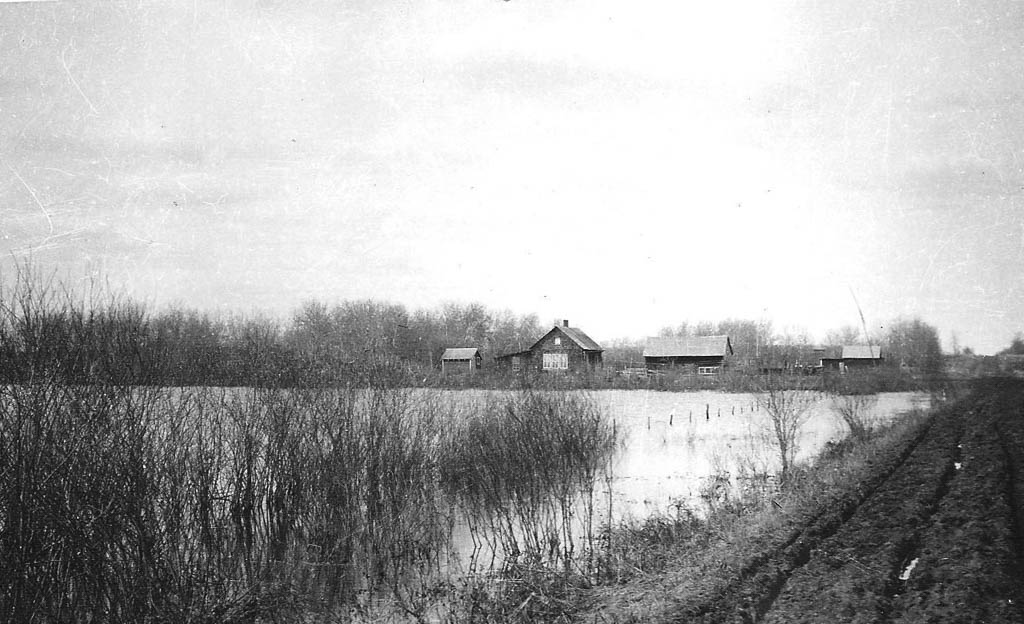
Altogether the Trautmans eventually cleared and broke 1,100 acres of farmland in the next 40 years. As they were successful farmers, they purchased more land and expanded their farming operation and equipment as funds became available. The Pete Trautman descendants continue to farm land west of Duhamel, however only one of John Trautman’s children stayed at Duhamel. That was my grandfather Pete.
Battle River Settlements and River Lots
The area was home to the Woodland Cree to the north and the Blackfoot people to the south. The Battle River was an informal boundary between the Cree and the Blackfoot nations. The fording place on the Battle River was known as “Notikewin Seppe” which translates to “crossing place”. On our river lots we have evidence of the locations where the First Nations people would spend the winters. They would excavate a small circular area which we believe they set their tepees over.
In 1883, the area was surveyed into “River Lots”. These are ¼ mile wide and use the river as one boundary and the normal section as the other boundary. This type of survey is also used at St Albert north of Edmonton. It is speculated that the lands were being squatted on at the time of survey and this was the way to divide the land in relation to those that occupied it.
At River Lot 30, the Battle River is very near the south side of the valley, so attached to River Lot 30 was 49 acres of hay meadow on the very north portion of River Lot 34. In this manner, each river lot had the combination of flat farmland and river valley land to produce hay and access water at the river. Some river lots had nice stands of spruce timber that provided building materials. This spruce timber was a blessing but also a curse. The green spruce logs were so large and heavy that they presented problems for the early settlers as they did not possess the means to deal with the large logs. Several instances of severe injury and long-lasting harm are noted in the local history.
Laboucane Settlement
The early name of the area before it was formally surveyed was the “Laboucane Settlement.” The first documented settlement was in 1875. The land along the Battle River was formally surveyed in 1883.
The majority of the Metis people built their homes some 75 feet from the lip edge of the Battle River Valley. The reason for this was the prevailing wind from the northwest would naturally down-draft into the valley, hit the opposite hill, run up in an arc, and fall back down some 150 feet from the lip of the valley edge. This fact I can attest to as our house is about 75 feet from the valley rim and the snow will fall straight down at the back of our yard near the rim of the valley. But further south away from the valley rim, the snow will drift while adjacent (0-15 feet) from the valley rim very little snow will fall.
The Laboucanes were born in White Horse Plains near Fort Garry. In 1878 the 6 brothers, their aged mother and two sisters made the trip to the Battle River. The Laboucanes and their relations as well as others to follow later were primarily freighters. They sustained themselves with food they raised or hunted and gathered.
Now we will work our way from west to east along the “Middle Battle Section” of the Waskahegan Trail. It includes the area west of Highway 21 to the Peter Fidler monument, which most Waskahegan Hikers will have visited.
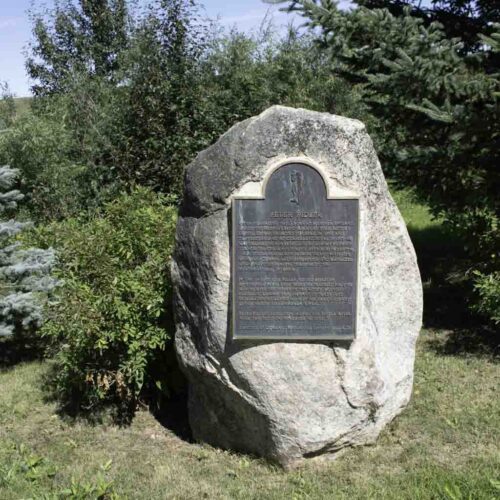
River Lot 28
River Lot 28 to the west of the Leon Parry Trading Post was homesteaded by Arsine Borque in 1893. This property is now owned by the Jones family who arrived in 1911 and still reside on NW 05-46-21-W4M. This river lot is the west end of the Waskahegan Middle Battle Section, and the west boundary is at the Peter Fidler Monument Cairn. Mrs. Bourque was for a time the housekeeper to Father Beillevaire, the Catholic mission priest at the church on the east side of Hwy 21.
River Lot 29
Leon Pare was the first white man to settle in the community. In 1878 Leon Pare arrived and set up on what would later be surveyed as River Lot 29. On River Lot 29. He set up a trading post and remained there for the next 25 years. Leon was employed by the Hudson Bay Company. He secured a quantity of furs each winter and made the trip back and forth to Winnipeg to deliver the furs and return with trade goods. Once the CPR tracks made it to Calgary in 1883, trips to Winnipeg were no longer the only way to source trade goods.
Leon Pare married a sister of the Laboucanes, Marie. Unfortunately, Marie passed away at the trading post in 1901.
In 1885, the year of the Riel Resistance, some Indigenous people swarmed into the settlement and informed Leon that they were going to kill all the white men in the area, to which Leon replied that this would be easy as he was the only white man there. They proceeded to enter the trading post with a log battering ram. They broke in and carried off a quantity of merchandise and the years’ catch of furs, which Leon had been unsuccessful in hiding. At that time the only white people living in the settlement were Leon Pare and Fr Beillevaire.
The Leon Pare Trading post was situated at the top of the river valley on land that you now travel through to the nicely mowed family gathering spot on the lower valley floor, known as Trautman Crossing. This spot is where the Trautmans still gather and had gathered for numerous years.
As a youngster, I recall climbing the steep hills from the flats up to wander around the two-story log structure of the old trading post and another single-story log structure that was reportedly the telegraph office. The next nearest office was in Hay Lakes. There exists a beautiful flowing spring on the east boundary of River Lot 31 and as kids we would make the three-quarter mile trek to taste the water there. It sure did taste good, or it had to because we had walked three quarters of a mile across cow pasture to get there.
Leon Pare sold River Lot 29 to Mike Durand in 1913, and Mike Durand sold it to the Trautman brothers Jim and Stan in the 1950s.
River Lot 30
Heading east from the Leon Pare Trading post is River Lot 30. Patrick Leville homesteaded this river lot in 1894. This land was later acquired by Joe Martz in 1923.
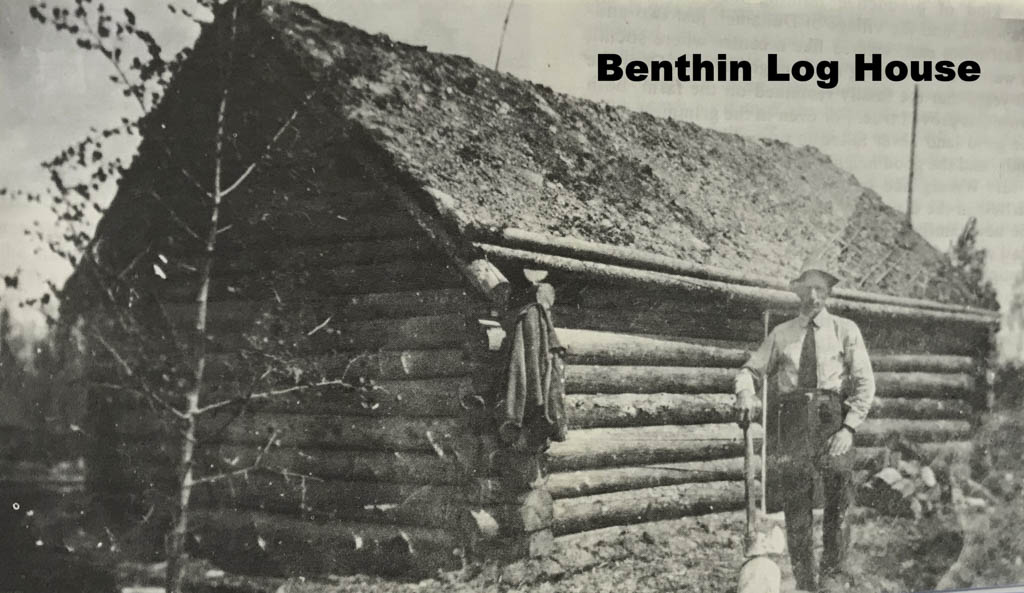
River Lot 31
River Lot 31 was homesteaded by Caroline Gariepy in 1899 and was acquired by Joe Martz from J.G Knudson in 1923.
Caroline Grant was married to Mr. Gariepy, who was killed at an early age in a hunting accident.
Caroline Grant remarried, to Alex Campion. They made their residence at Tail Creek near Buffalo Lake and Content Bridge. The Tail Creek settlement at one time had a population of close to 2000 people so Caroline Gariepy Campion moved to the smaller settlement at the Battle River. It is a common theme among the early settlers that they were looking for an area to live and forge a life with less population in the very near vicinity.
Their son, Dolphus Campion was born at the Battle River in 1884 on River Lot 31. Dolphus was 90 years old in 1973 and was a very good resource on the history of the area. The editors of the history book interviewed Dolphus in 1973. He was considered a living encyclopedia when it came to the early history of the Laboucane Settlement.
In 1885, Alex Campion was injured carrying a heavy spruce log from which he never recovered.
Mrs. Gariepy Campion was known as a very enterprising young lady. During the winter she resided with her family at the Battle River. In the spring she took off with young Dolphus in the back of the “buckboard” for Calgary where she operated a freighting outfit to Edmonton. While on one of the many trips, during a lunch break, the young Dolphus unscrewed the nut from one of the back wheels. The group took off after lunch. It was not long until the wheel fell off and young Dolphus who was in the back of the buckboard was thrown out along with a hatchet that was lying in the back as well. The hatchet cut a gash in his head and his mother had to bring the trip to a halt to repair the bleeding head of the young Dolphus and get the wheel back on the buckboard.
Mrs. Gariepy’s freighting outfit consisted of two men, ten red river carts and some horses. One of the men would ride a horse to lead the caravan. Each Red River cart would be drawn by one horse and the next cart would follow behind. None of the horses were tied to the cart ahead as they followed obediently behind the other. The second man on the crew employed his time by keeping the convoy in order prodding along the strays and generally overseeing the whole operation.
Mrs. Gariepy continued to freight from Calgary to Edmonton until 1892 when the C and E branch line was completed. After that, she continued her freighting operation during the summer months from Edmonton to Athabasca. Caroline Grant Gariepy Campion passed away in 1899.
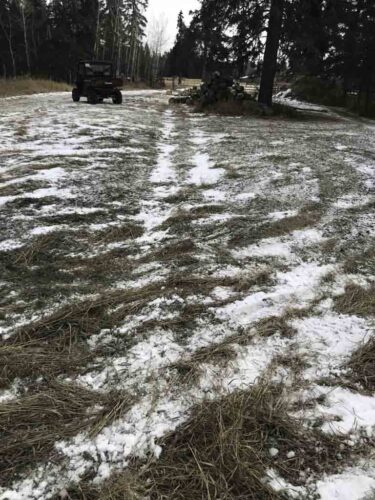
The cart trails can still be identified on River Lot 31, at the time of the year when they are not overgrown with grass.
When I first noticed them, I could not figure out what they were as they were only 30 inches wide. Upon further research on the Red River carts, I realized the carts are only thirty inches wide.
Joe Martz acquired River Lot 31 and had a large two-story log and timber house on the property when it was purchased by the Trautmans.
The Trautmans were successful farmers and were well aware of the fine quality of the farmland along the Battle River Valley. The land was well sloped. Very little water would pond on it, and it would quickly soak away in the spring.
The Trautman brothers purchased River Lots 30 and 31 in the 1950s from Joe Martz. The land purchase price for the two river lots (total 280 acres) is the cost of one single acre of farmland value today.
The hillside was a valuable source of timber and was harvested on different occasions to support the growth of the farm buildings. The Trautman’s last harvested timber came from the three river lots in 1979. The barn that I built on River Lot 31 is entirely built with lumber harvested in 1979.
Although the upland was very productive farmland and was highly valued, the lower valley in the early years was not as highly valued as it is today. The hillside was a convenient place to dump garbage over the edge and the valley was quite often wet and not easily utilized for anything other than grazing. The flow of the Battle River itself has changed greatly over the years with the change in farming practices and the drainage of the adjacent farmland.

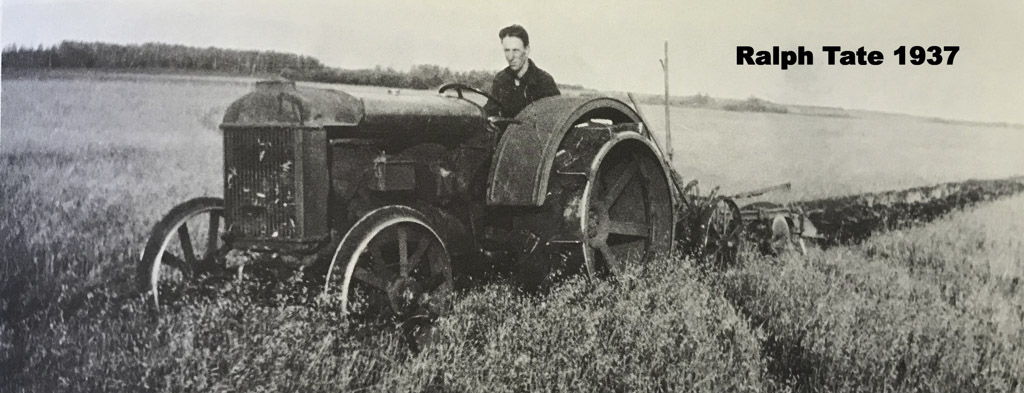
River Lot 32
Homesteaded by Elzear Poitras in 1890. Not much early history is available about River Lot 32. It is now owned by Dennis and Jessica Knelsen.
River Lot 33
Homesteaded by Francois Poitras in 1890, now owned by the Hutchinson family which we will learn more about.
River Lot 34
Homesteaded by Lew Hutchinson in 1900.
Lew Hutchinson had attended college in Ann Arbor Michigan, and later was a cowboy in Nebraska and then in Oskaloosa Iowa. There, the young Lew met a land agent who tried to sell Lew on the idea of a homestead in Alberta.
In 1892 Lew travelled by way of the Soo Line of Southeastern Saskatchewan. He was not impressed with the southern part of this territory because the grass was so short, brittle and not suitable for ranching.
When Lew arrived in Wetaskiwin on the C and E Railway, he hired a horse from the livery stable and took off twenty miles east to look over some homestead land available in the district. It took him two days to reach the land as there was snow on the ground and it ws quite foggy. He selected a site on the north side of the Battle River as he was impressed with the blackness of the soil brought up by some pocket gophers. He paid the $10 to the land agent and returned to Oskaloosa to collect his worldly possessions.
The next spring Lew rode out to his homestead to begin his farming operations. He was disappointed in the land he had selected when he discovered there was no running water. He crossed the Battle River to the south side and arrived at an ideal spot. It was on the bank of a lovely coulee which was heavily treed with spruce and poplar and flowing with an ever-flowing stream of fresh spring water. He forfeited his $10 homestead fee and proceeded to make an agreement with Pierre Cyr who held the squatter’s rights to the land.
The squatter was in Hay Lakes at the time. Lew had one horse and he borrowed another horse to meet with Pierre Cyr in Hay Lakes. Mr. Cyr was in great need of a wagon at the time. Lew did not possess a wagon but agreed to the $60 for Mr. Cyr to purchase one for the right to file for the homestead rights to River Lot 34. Lew made his home on this land for the rest of his life. The land at “Spruce Coulee” is still in his offspring’s name to this day.
A small school was built across the coulee from the Hutchinson homestead. A teacher from the nearby New Norway school district was recruited to teach school there. Miss Middleton, a young lady of Scottish descent, took a position to teach at the school. It is reported that the horse that she rode from where she was boarding at the Binghams’ developed bronco symptoms at the end of classes each day. So, Lew often picked her up in his buggy and took her home, the saddle horse obediently following behind. They became a couple and were married on New Year’s Eve 1902. The children all bore Middleton in their names the maiden name of their mother.
The Hutchinsons had a very successful mixed farming operation, and their house was a center of activity in the community.
The Trautman family had a close relationship with the Hutchinson family as the northern-most 49 acres of River Lot 34 was attached to River Lot 30 and there was no surveyed access to this property. The goodwill of the Hutchinsons was required to access the hay meadow. My early recollection of the Hutchinsons was visiting their house while my dad had to deal with a twisted off axle on a 1-ton truck while hauling hay from the valley in deep snow.
River Lot 35
This land was homesteaded by Francis Walker in 1890. It is reported that Mrs. Walker enjoyed smoking an old clay pipe and that there were a number of girls in the family. Shortly after the turn of the century, they moved to the Red Willow District. This land is now owned by the Hutchinson family.
River Lot 36
Jim Patterson was a single man who came to the community in the 1890s from the United States. Not much is known other than Jim Patterson provided the horse and wagon in 1899 to Lew Hutchinson to travel to Hay Lakes to obtain the squatters’ rights to River Lot 34.
This land was the home farm of Clarence Scheie and was purchased by Border Paving. It is home to a gravel pit.
River Lot 37
Homesteaded by Elzear Laboucane in 1886. A store was operated by Elzear on this plot of land.
This property is now owned by Alberta Transportation and is an active gravel pit
River Lot 38
Homesteaded by Daniel Laboucane. This property is now owned by Alberta Transportation and is an active gravel pit.
River Lot 39
Homesteaded by Joseph Z. Neveu. Highway 21 into the river Valley is on this river lot. This is the east end of the “Middle Battle” section of the Waskahegan Tail.
Duhamel
In 1881 Jerome Laboucane travelled to Bear Hills to invite the Catholic priest, Father Beillevaire, to set up a mission at the Laboucane Settlement. Speaking French and finding that the Laboucanes also spoke French, the priest moved from Bear Hills to the Laboucane Settlement. A church was built in 1883.
In 1886 Archbishop Grandin visited the outpost and at that time the name Duhamel was chosen as the name of the settlement, after Archbishop Duhamel in Ottawa.
Archbishop Duhamel visited the Saint Albert Mission in 1892 and donated a bell for the tiny mission church.
“Old” Duhamel was a thriving community with multiple stores, a hotel, a creamery, and a blacksmith shop at the point where Hwy 21 crosses the Battle River valley today.
George Smith operated a store and, in some weeks, made more than 1000 dollars in sales. Wetaskiwin was the closest bank and the post office in Duhamel was the only place between Wetaskiwin and Noth Battleford where money orders could be purchased and sent from or received. It was not uncommon for there to be $3000 to $4000 in cash on hand at any one time. This money was usually stuffed into two tin boxes and carried to the storm operator’s bedroom each night. At one time the post office store had in excess of $8000 on hand. Fortunately, no robberies were reported.
Between 1900 and 1910 old Duhamel was where the action was, and it was known as a good community in which to live. Fur trading was an important and fascinating phase of the pioneer life at old Duhamel. The French and Metis settlers were splendid hunters and trappers. Their annual income from the sale of furs was at least $150 per year. The Laboucanes had established Duhamel as a home base for their freighting operations from Edmonton to Winnipeg.
Toward the end of the first decade of the 20th century, the Grand Trunk Pacific railway was built south from Tofield to Calgary. It ran south from Camrose and passed over the Battle River Valley on the highest and longest bridge in the world at that time.
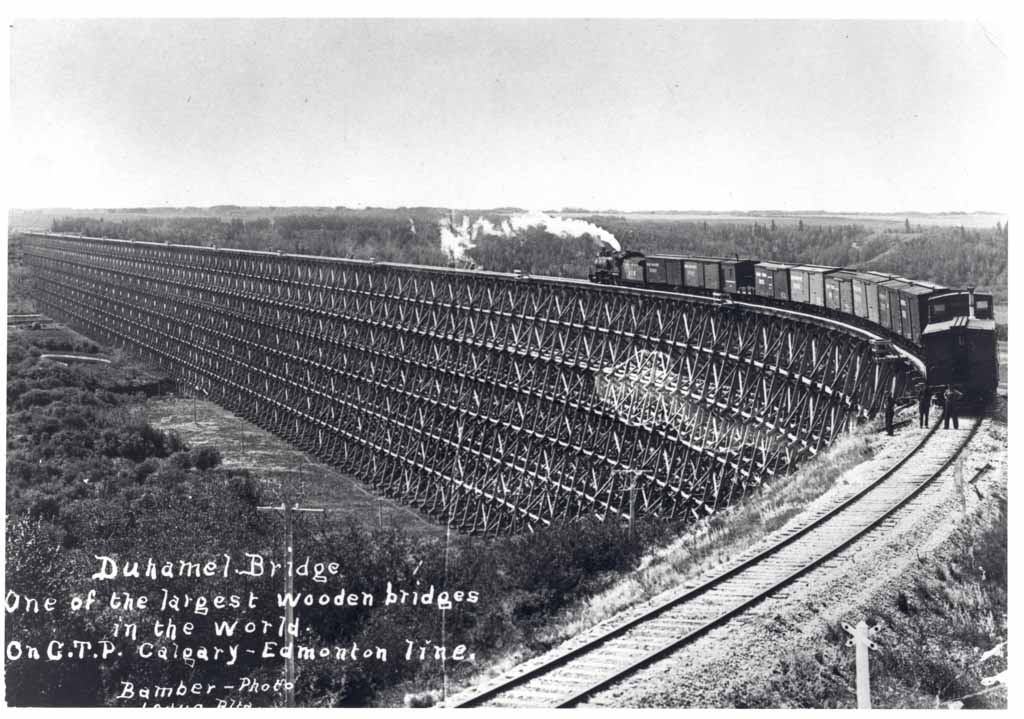
The arrival of the railroad was the end of all the commercial and community activity along the banks of the Battle River and the businesses that had established there. It was during this time that the businesses began to pull up stakes and move to a community 10 miles to the northeast, It was apparent that Camrose was going to become a growing and thriving community at the intersection of multiple railway lines. Old Duhamel was bypassed by the Grand Trunk Railway Bridge over the valley.
The railway negated the method of movement of goods by freighters, a service that the Gariepys and the Laboucanes had provided.
New Duhamel and an era of change
A new townsite for Duhamel was formally surveyed when the Grand Trunk Pacific Railway was surveyed. From 1910 to 1920, the little Catholic mission still stood, and Father Beillevaire still attended to the needs of his parishioners and conducted mass from the little church that still stands today.
While the river lots were still occupied, many changes were happening in the old community centered in the valley.
The Shamrock Hotel and the Smith store moved to the hamlet of Duhamel to the south. It is reported that the Shamrock Hotel bar remained open while being pulled by teams of horses from its old location in the Battle River Valley. Those buildings still at the site of old Duhamel were falling into a state of decay.
The Duhamel Railway Bridge spanned the valley and the district resounded to the whistles of locomotives as they drove across the valley, running north and between Edmonton and Calgary. The arrival of the railways brought new settlers into the district and the transporting of cattle and grain outward to markets.
The era from 1910 to 1920 at Duhamel was in many respects very similar to other locations in Alberta. The new settlers had been pioneers in other districts and were seeking to develop new homes for their families. It was characterized by the boom in land development and the introduction of mechanized farming practices, and by the building of respectable homes and farm buildings. Oxen were replaced by horses as a source of farm power. The Model T Ford car made its appearance on roads and by 1920 had become a common sight.
World War I had come and gone. The war had impacted the whole community and shocking losses were felt in many of the homes in the district.
The ten years following 1910 were times of great happiness and much sorrow—but they were stirring times. They brought into the communities a host of young people who had come from other parts of the world with the experiences and desire to fulfill the dreams they held.
Many families moved out as the lifestyle they had come to enjoy at the Laboucane Settlement, later called Duhamel, had evolved. They left in pursuit of that lifestyle in other communities, just as those who moved into the community were trying to attain. Today no relatives of the Laboucanes reside in the area. It is pondered that the freedom and lifestyle that had brought the early settlers to the banks of the Battle River valley had changed and the prospect of that lifestyle drew them to move elsewhere.
Learn More
Pat’s son Jordan wrote a prize-winning essay on the history of the Duhamel Trestle. You can view it here in the Camrose Booster.
